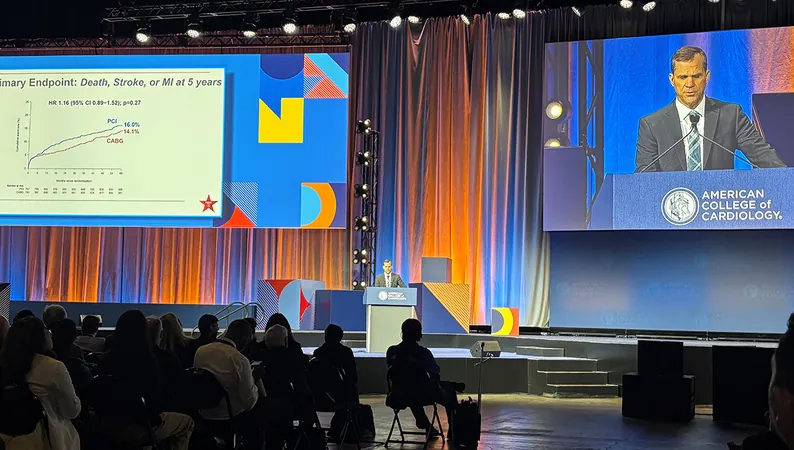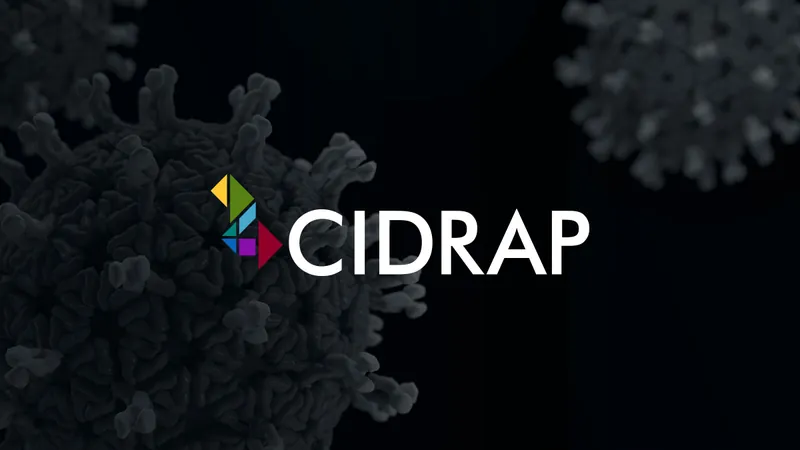
Surprising New Data: PCI Patient Outcomes Match Those of CABG After Five Years!
2025-03-31
Author: Wei Ling
CHICAGO, IL
– A groundbreaking revelation from the final follow-up of the FAME 3 trial reveals that patients suffering from three-vessel coronary artery disease who underwent fractional flow reserve (FFR)-guided percutaneous coronary intervention (PCI) experienced clinical outcomes equivalent to those treated with traditional coronary artery bypass grafting (CABG) after five years. This shocking turn of events could reshape the future of cardiac care!
The study found no significant difference in the combined rates of death, stroke, or myocardial infarction (MI) between the two treatment groups, although patients undergoing PCI did experience higher rates of MI and repeat revascularization procedures. This is particularly intriguing as the initial findings of FAME 3 indicated that at one year, PCI did not demonstrate noninferiority compared to CABG.
Dr. William F. Fearon from Stanford University, the lead investigator for FAME 3, presented these important findings at the American College of Cardiology's (ACC) 2025 Scientific Session, with results concurrently published in *The Lancet*. Fearon pointed out that most prior studies comparing PCI to CABG are outdated and do not account for advancements in medical and surgical techniques, as well as medical therapies available today.
FFR-guided PCI represents the latest advancements in cardiac care, utilizing state-of-the-art drug-eluting stents and optimal medical therapy. Dr. Akshay Khandelwal from Allegheny Health Network emphasized that these data signify a transformative approach to treating patients, suggesting that PCI, when anatomically guided and supported by robust medical therapy, can yield similar outcomes to CABG in many instances.
The FAME 3 trial was a significant, investigator-initiated study conducted across 48 centers globally, involving 1,500 patients. Participants were randomized to either receive FFR-guided PCI or CABG based on angiographic findings. At the five-year mark, follow-up data was available for an impressive 96% of PCI candidates and 94% of those who underwent CABG. Notably, more than 90% of patients in both groups adhered to antiplatelet therapy and statin use, reflecting excellent management of their coronary artery disease.
Fearon highlighted that despite the similar outcomes concerning death, stroke, or MI, patients who had PCI faced significantly higher rates of MIs and required additional revascularizations. However, a landmark analysis suggested that there was no late advantage to CABG treatment after one year, leading to questions about the long-term viability of the traditional surgical approach.
Moreover, the FAME 3 findings revealed that patients with low and high SYNTAX scores had similar outcomes regardless of their treatment, whereas individuals with intermediate scores fared much worse with PCI—a critical point for integrating patient-specific scoring in treatment decisions.
Comparing FAME 3 to the earlier SYNTAX trial, which primarily evaluated outcomes at five years, reveals stark contrasts. The death/stroke/MI rate for PCI in SYNTAX was 22%, significantly higher than the 16% observed in FAME 3 data, indicating marked improvements due to technological advances in stents and adherence to medical guidelines in contemporary practice.
These insights may empower physicians and patients alike to engage in more informed decision-making regarding treatment strategies for multivessel disease. With FFR technology enhancing coronary physiology assessments, the landscape of cardiac interventions appears poised for a revolution.
In a statement reflecting on the findings, Dr. S. Chris Malaisrie, a cardiac surgeon from Northwestern University, elaborated on the implications of FFR use in PCI, suggesting it often leads to fewer stents being implanted—an intriguing point for further exploration. He questioned the utility of FFR in CABG decisions, suggesting that its potential benefits might not be as clear-cut in surgical contexts, despite prior trials indicating limited advantages.
With these new revelations, the ongoing dialogue around the efficacy of PCI versus CABG will surely continue to evolve, promising to reshape the future of cardiac treatment options. As researchers and clinicians alike are excited by the advancements in procedural techniques, patients can look forward to new, less invasive options that can lead to outcomes comparable to traditional surgery. Stay tuned for more developments in this fast-evolving field!



 Brasil (PT)
Brasil (PT)
 Canada (EN)
Canada (EN)
 Chile (ES)
Chile (ES)
 Česko (CS)
Česko (CS)
 대한민국 (KO)
대한민국 (KO)
 España (ES)
España (ES)
 France (FR)
France (FR)
 Hong Kong (EN)
Hong Kong (EN)
 Italia (IT)
Italia (IT)
 日本 (JA)
日本 (JA)
 Magyarország (HU)
Magyarország (HU)
 Norge (NO)
Norge (NO)
 Polska (PL)
Polska (PL)
 Schweiz (DE)
Schweiz (DE)
 Singapore (EN)
Singapore (EN)
 Sverige (SV)
Sverige (SV)
 Suomi (FI)
Suomi (FI)
 Türkiye (TR)
Türkiye (TR)
 الإمارات العربية المتحدة (AR)
الإمارات العربية المتحدة (AR)